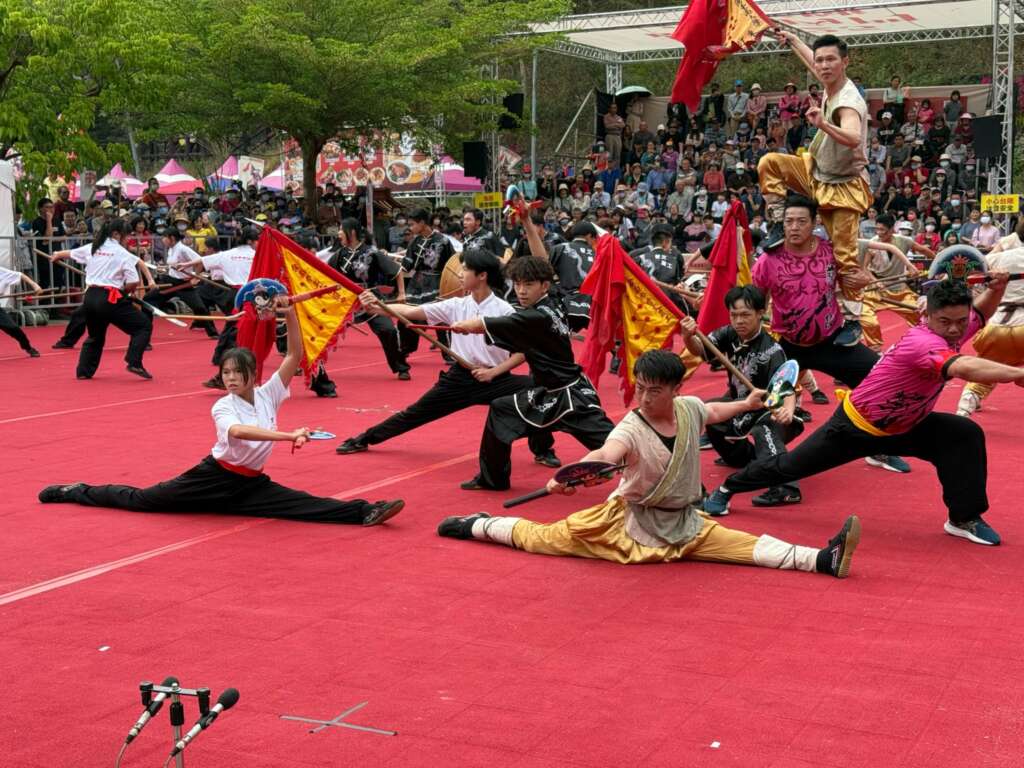Drums roll and reeds buzz. Young people in colourful outfits rush and fight each other in perfect synch. On three sides, rows of seats have been erected for the audience to watch in awe at the youngsters screaming and kicking in unison. On the fourth side, an enormous, richly ornamented temple towers over the scene. Even in the temple, you can find an altar to a warrior god, surrounded by racks of medieval weapons — hooks, spears, daggers on long poles.
They know how to protect themselves in this area: the Neimen district, one hour’s drive north of Kaohsiung. And on this fresh day of April, the temple hosts the Songjiang Battle Ritual.
Around Shunxian Temple, a temporary market sprawls with food trucks and booths for visitors. Soon, warriors appear, sporting impressive face paint and costumes reminiscent of medieval times. In the afternoon, most of them will be competing in an arena set up beside the temple. Part of performing bands often organized around universities, they will showcase their skills in a theatrical, choreographed martial arts battle.
Every year, the event’s venue rotates between a few of Neimen’s temples. Shunxian Temple is the largest. It includes altars to several Taoist deities, the main one being dedicated to Mazu, the Sea-Goddess. On the ceiling, a single, enormous piece of wood has been carved to represent nine dragons intertwined. Artworks are everywhere, painted on wood panels and ceilings, and chiseled in stone walls. But near the entrance, an altar to a war deity is surrounded by ancient weapons — the kind that competitors will use in their performances.

All the temples involved in the Neimen traditions are somewhat linked to this fighting spirit, and to the long-lasting tradition of local resistance to outsiders. Mornings are the occasion for visitors to be introduced to these other temples. One of them, Nanhai Zizhu Temple, is accessible via a pathway ornamented with martial arts paintings.
Another one is built facing a monumental statue of Zhu Yigui, who rose from duck farmer to short-lived emperor on Taiwan. Another statue bears a plaque telling his story and represents him surrounded by the animals that granted him the nickname “Duck Emperor.” Zhu Yigui led a coalition of Hokkien-speakers, Hakka, and Taiwanese Aborigines to kick the Chinese authorities off the island for a short time in 1721. The history of Taiwan is made of these successive layers and alliances.

The area of Neimen reveres martial arts. Near another temple, a small museum is dedicated to the many weapons used by local militias in the past. A guide even demonstrates their use. All of them stem from peasant tools: one spear with a vicious hook is described as being shaped both to pull horsemen down from their mounts and reap the harvest. This is the realm of warrior-peasants defending their land.
During the battle competition, large teams enter the stage for performances that last around half an hour each. They typically divide themselves into two rival teams that engage in a mock battle, with an underlying story rooted in legends or historical episodes. One of the teams, The Heroes of Liangshan (梁山英雄鎮北番), come dressed in splendid colours, wave large flags and display remarkable energy as they pretend to fight each other. Girls and boys appear in equal numbers. They want to look frightening, and they succeed. The music is constant and thundering.

There is something exhilarating about the youthful energy of it all. After the event is over, the performers are once more ordinary students, laughing from stall to stall with a phone in hand, ready to share their happy day online with their friends. Moments before, during the battles, they appeared fierce, expressing the lethal, invincible fighting spirit that lies at the core of martial arts. There was a sense of pride in all their gestures, all their postures, static or in movement, even when they carry away their props after the show. Strong eyes, austere expressions, sudden screams, precise hits — all enlighten their teenage-like features, turning young people into warriors carrying their country on their shoulders.
In the end, most teams will receive awards for specific aspects of their performances. But the most coveted one rewards the best team of the year. The winners, Fengwu Xinchuan-Xiluo Fengshan Pavilion (鳳武薪傳西螺鳳山館), appeared significantly different from others. Instead of evoking medieval times, they looked straight out of 1900. In music, costumes, and fights, they told the story of Liao Tian-ding, a historical character often said to be Taiwan’s own version of Robin Hood. During the time of Japanese occupation of Taiwan, Liao robbed the colonial authorities for the benefit of locals.
What was displayed and rewarded that day is the spirit of freedom that cannot be tamed. This is a typical vibe for South Taiwan. The Chiang regime was born in the North, but Taiwan was born in the South. The divide between the two sides of the country is subtle but deep, and exploring the cultural markers of South Taiwan greatly helps in understanding its identity. It is worth noting that some of the teams came from the North but embraced the Southern tradition, too.
We do not even need to mention what kind of resistance to invaders the ritualized battles and traditions evoke to the modern mind. But it is also a strong symbol of alliance between the multiple communities of Taiwan, a country much more diverse linguistically and culturally than life in the capital would suggest. In this admixture resides its rejuvenation and its spirit of resistance.

